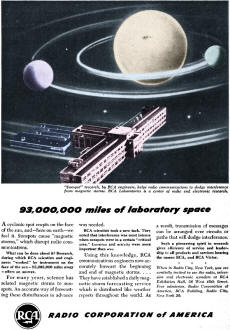Radio Corporation of America - Solar Flares
|
|
When this infomercial from Radio Corporation of America (RCA) describing the effects of sun spots and their associated solar flares appeared in a 1948 issue of Popular Science magazine, the science of coronal mass ejections (CME) had not yet been established. That began in 1971 with the first visual detection by the Orbiting Solar Observatory 7 satellite. The difference between a solar flare and a CME is basically one of magnitude. Flares are typically visually bright and send out energetic particles at near the speed of light, and reach Earth in a matter of a few minutes. A CMEs is an enormous spewing of solar mass (primarily a plasma of electrons and protons); its particles can take between half a day and many days to get here. The Carrington Event of 1859 is one of most significant CMEs documented (before anyone knew about CME). Both interact with the upper atmosphere, but a CME can generate extreme electrical and magnetic fields that interrupt RF communications and can disrupt electrical distribution grids. A common comparison is that a solar flare is like a muzzle flash whereas a coronal mass ejection is like the leaden projectile. Radio Corporation of America Ad
93,000,000 miles of laboratory space A cyclonic spot erupts on the face of the sun, and - here on earth - we feel it. Sunspots cause "magnetic storms," which disrupt radio communications. What can be done about it? Research, during which RCA scientists and engineers "worked" by instrument on the face of the sun - 93,000,000 miles away - offers an answer. For many years, science has related magnetic storms to sunspots. An accurate way of forecasting these disturbances in advance was needed. RCA scientists took a new tack. They noted that interference was most intense when sunspots were in a certain "critical area." Location and activity were more important than size. Using this knowledge, RCA communications engineers now accurately forecast the beginning and end of magnetic storms ... They have established a daily magnetic storm forecasting service which is distributed like weather reports throughout the world. As a result, transmission of messages can be arranged over circuits or paths that will dodge interference. Such a pioneering spirit in research gives efficiency of service and leadership to all products and services bearing the names RCA, and RCA Victor. When in Radio City, New York, you are cordially invited to see the radio, television and electronic wonders at RCA Exhibition Hall, 36 West 49th Street. Free admission. Radio Corporation of America, RCA Building, Radio City, New York 20. Radio Corporation of America
Posted February 5, 2024 |
|

